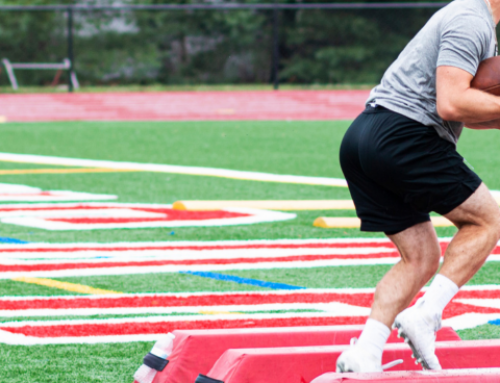Master 6 Crucial Football Combine Drills
Just like the SAT, ACT or your midterm in Spanish III, a football combine is a test—one that you can ace if you study. Good news: “studying” for this particular test means learning to run faster, jump higher, and just plain kick more butt in the gym.
When combine day comes, how you perform six key drills will be evaluated by recruiters to measure your athletic potential. (Check out Maintain Staying Power in College Recruiting.) Here’s a pre-test report on each, along with tips to help you perform your best when combine day comes.
40-Yard Dash
Simple though it is, “The 40”—where you run 40 yards in a straight line as fast as you possibly can—is widely considered the most important drill at the combine. Shaving even one-tenth of a second off your time can catapult you from a preferred walk-on to Blue Chip status. But your finish time isn’t the only thing you’ll be evaluated on. Recruiters take three readings during the dash, looking for something different in each segment.
- At 10 yards: Here they are measuring your power, trying to see how quickly you get off the line.
- At 20 yards: Your time at the halfway mark shows your ability to accelerate. How long does it take you to reach top speed?
- At 40 yards: How you run the home stretch says a lot about your endurance. Once you reach full throttle, can you maintain it? Do you continue to speed up and close hard, or fade and slow down?
If you’re like most high school footballers, you’ve probably worked on your blocking, tackling or catching, but not your ability to run in a straight line, unobstructed. So a little 40-specific training can go a long way. By improving your mechanics, flexibility and sprinting strength, you can realize a significant improvement in your time. (Learn how with the TD1 Minute: 40-Yard Dash Training Program.)
Tip: When coming out of the starting blocks, keep your chin down to avoid rising up too quickly. If you stand up too fast, you will limit the power of your leg drive. Aim to stay low for the first 15 to 20 yards of the sprint.
Bench Press
Most people assume the Bench tests a player’s maximum strength, but what it really evaluates is strength endurance. No one “maxes out” at the combine; rather, each athlete is asked to press a specific weight as many times as he can. Although piling on the 45-pound plates may impress your friends at the gym, on combine day, coaches want to see how many times you can move a more moderate load.
Tip: Do your homework. Find the weight you’ll need to bench at your combine. From there, focus your strength sessions on mastering that amount.
At least once before the combine, do a dress rehearsal with friends watching as you rep out at the target weight. That way, you’ll be used to the attention when you’re in front of recruiters. (For an extra advantage, see how trainer Kurt Hester preps his athletes in the TD1 Minute: The Bench Press.)
Vertical Jump
Jumping for height measures an athlete’s ability to generate power with his legs, an important gauge of lower-body strength. The drill is deceptively simple. You stand flatfooted, slightly in front of a vertical jump pole, with one arm extended directly above his head. Without taking a step, you then jump as high as you can, reaching for the highest possible measuring flag.
Tip: Ground-based lifts like the Power Clean and Snatch, along with Box Jumps, can help improve foot-to-ground power. (To perfect your jump technique, see TD1 Minute: Vertical Jump Technique.)
Standing Broad Jump
This is another test of a player’s power output from a standstill position, only in this drill performance is measured horizontally rather than vertically. You toe a line, crouch down and then leap forward as far as you can. Distance is measured from the starting line to the heel of your rear landing foot, so aim to land evenly on both legs and avoid having one foot trail behind.
Tip: Horizontal plyometric training—as with Sled Pushes, Bounding and Dynamic Broad Jumps—help build the specific strength this test measures. But nothing prepares you for this drill like practicing the drill itself, so incorporate the Standing Broad Jump into your weekly training sessions.
3-Cone Drill (L-Drill)
The 3-Cone Drill, or “L-Drill,” tests agility, acceleration and speed. The drill gets its name from its set-up: three cones positioned five yards apart in the shape of an “L.”
Starting at one cone, you sprint straight ahead to the second cone, then quickly reverse direction and run back to the starting cone. Next, you sprint again to the second cone, hang a hard right turn and speed to the third cone, which you loop around from the inside out, then retrace your steps back around the second cone to the starting cone.
When all is said and done, you will have run 30 yards total and made three sharp turns along the way.
Tip: To prepare yourself for this test, work on change-of-direction drills like the Pro Agility Drill and the 180-Degree Run and Turn. Focus on staying low out of the breaks and improving your ability to accelerate quickly and precisely. Finish every drill at full speed, as every tenth of a second counts. (For in-depth preparation, see TD1 Minute: Three-Cone Drill.)
Pro Agility Drill
Another change-of-direction test, this one measuring lateral movement, the Pro Agility Drill places two cones 10 yards apart with a third in the middle at five yards. You start at the middle cone in a three-point stance. When the whistle blows, run five yards to an end cone, touch it with your hand, then change direction and sprint 10 yards and touch the opposite cone. To finish, change course yet again and dash back past the starting point.
Tip: Practice this drill long before the combine, and when you do, have a partner film you running through the cones. You will be able to see exactly where you need to improve your skills. Do you turn left faster than you turn right? Are you standing too upright, costing you valuable time when you reach down to touch the cones? Reviewing the tape, you’ll confront your performance head-on and know precisely what to do to get better.
RECOMMENDED FOR YOU
MOST POPULAR
Master 6 Crucial Football Combine Drills
Just like the SAT, ACT or your midterm in Spanish III, a football combine is a test—one that you can ace if you study. Good news: “studying” for this particular test means learning to run faster, jump higher, and just plain kick more butt in the gym.
When combine day comes, how you perform six key drills will be evaluated by recruiters to measure your athletic potential. (Check out Maintain Staying Power in College Recruiting.) Here’s a pre-test report on each, along with tips to help you perform your best when combine day comes.
40-Yard Dash
Simple though it is, “The 40”—where you run 40 yards in a straight line as fast as you possibly can—is widely considered the most important drill at the combine. Shaving even one-tenth of a second off your time can catapult you from a preferred walk-on to Blue Chip status. But your finish time isn’t the only thing you’ll be evaluated on. Recruiters take three readings during the dash, looking for something different in each segment.
- At 10 yards: Here they are measuring your power, trying to see how quickly you get off the line.
- At 20 yards: Your time at the halfway mark shows your ability to accelerate. How long does it take you to reach top speed?
- At 40 yards: How you run the home stretch says a lot about your endurance. Once you reach full throttle, can you maintain it? Do you continue to speed up and close hard, or fade and slow down?
If you’re like most high school footballers, you’ve probably worked on your blocking, tackling or catching, but not your ability to run in a straight line, unobstructed. So a little 40-specific training can go a long way. By improving your mechanics, flexibility and sprinting strength, you can realize a significant improvement in your time. (Learn how with the TD1 Minute: 40-Yard Dash Training Program.)
Tip: When coming out of the starting blocks, keep your chin down to avoid rising up too quickly. If you stand up too fast, you will limit the power of your leg drive. Aim to stay low for the first 15 to 20 yards of the sprint.
Bench Press
Most people assume the Bench tests a player’s maximum strength, but what it really evaluates is strength endurance. No one “maxes out” at the combine; rather, each athlete is asked to press a specific weight as many times as he can. Although piling on the 45-pound plates may impress your friends at the gym, on combine day, coaches want to see how many times you can move a more moderate load.
Tip: Do your homework. Find the weight you’ll need to bench at your combine. From there, focus your strength sessions on mastering that amount.
At least once before the combine, do a dress rehearsal with friends watching as you rep out at the target weight. That way, you’ll be used to the attention when you’re in front of recruiters. (For an extra advantage, see how trainer Kurt Hester preps his athletes in the TD1 Minute: The Bench Press.)
Vertical Jump
Jumping for height measures an athlete’s ability to generate power with his legs, an important gauge of lower-body strength. The drill is deceptively simple. You stand flatfooted, slightly in front of a vertical jump pole, with one arm extended directly above his head. Without taking a step, you then jump as high as you can, reaching for the highest possible measuring flag.
Tip: Ground-based lifts like the Power Clean and Snatch, along with Box Jumps, can help improve foot-to-ground power. (To perfect your jump technique, see TD1 Minute: Vertical Jump Technique.)
Standing Broad Jump
This is another test of a player’s power output from a standstill position, only in this drill performance is measured horizontally rather than vertically. You toe a line, crouch down and then leap forward as far as you can. Distance is measured from the starting line to the heel of your rear landing foot, so aim to land evenly on both legs and avoid having one foot trail behind.
Tip: Horizontal plyometric training—as with Sled Pushes, Bounding and Dynamic Broad Jumps—help build the specific strength this test measures. But nothing prepares you for this drill like practicing the drill itself, so incorporate the Standing Broad Jump into your weekly training sessions.
3-Cone Drill (L-Drill)
The 3-Cone Drill, or “L-Drill,” tests agility, acceleration and speed. The drill gets its name from its set-up: three cones positioned five yards apart in the shape of an “L.”
Starting at one cone, you sprint straight ahead to the second cone, then quickly reverse direction and run back to the starting cone. Next, you sprint again to the second cone, hang a hard right turn and speed to the third cone, which you loop around from the inside out, then retrace your steps back around the second cone to the starting cone.
When all is said and done, you will have run 30 yards total and made three sharp turns along the way.
Tip: To prepare yourself for this test, work on change-of-direction drills like the Pro Agility Drill and the 180-Degree Run and Turn. Focus on staying low out of the breaks and improving your ability to accelerate quickly and precisely. Finish every drill at full speed, as every tenth of a second counts. (For in-depth preparation, see TD1 Minute: Three-Cone Drill.)
Pro Agility Drill
Another change-of-direction test, this one measuring lateral movement, the Pro Agility Drill places two cones 10 yards apart with a third in the middle at five yards. You start at the middle cone in a three-point stance. When the whistle blows, run five yards to an end cone, touch it with your hand, then change direction and sprint 10 yards and touch the opposite cone. To finish, change course yet again and dash back past the starting point.
Tip: Practice this drill long before the combine, and when you do, have a partner film you running through the cones. You will be able to see exactly where you need to improve your skills. Do you turn left faster than you turn right? Are you standing too upright, costing you valuable time when you reach down to touch the cones? Reviewing the tape, you’ll confront your performance head-on and know precisely what to do to get better.











